Vice President Venkaiah Naidu’s tenure will expire on August 10, hence the Election Commission of India has stated that the 2022 vice-presidential election would take place on August 6. The deadline for filing nominations for the election is July 19.
According to Article 68 of the Constitution, the Vice President of India’s Election must be concluded prior to the expiration of the term in order to fill the vacancy created by the outgoing Vice President’s term of office. The second-highest constitutional position in India is that of the vice president who serves as the Rajya Sabha’s “ex-officio” Chairperson.
How Vice President is elected in India?
The members of the electoral college, which consists of representatives from both Houses of Parliament, choose the vice president of India. 788 members from each of the two Houses of Parliament make up the Electoral College. The Electoral College for the 16th Vice-Presidential Election in 2022 is made up of 233 elected Rajya Sabha members, 12 nominated Rajya Sabha members, and 543 elected Lok Sabha members.
Constitutional mandate as Vice President
India’s vice-president is the country’s second-highest constitutional position. In case of the absence of the current President, he serves in that capacity. He also serves as the ex officio chairman of the Rajya Sabha. The Vice President does not hold membership in any political party or other paid post, which speaks to his impartiality and apolitical nature. Furthermore, the Vice President’s remarks gain a national significance due to his constitutional standing. Statements made by the departing vice president about matters such as press freedom and the welfare of minority communities sparked several media disputes and garnered considerable attention.
Roles of Vice-President in India
The Vice President, who serves as Chairman of Rajya Sabha, has the last say in how the Constitution and the Rules of Procedure should be interpreted for all matters pertaining to the House. His verdicts become binding precedent. Additionally, he decides whether a Rajya Sabha member should be dismissed due to desertion. He is a significant player in the operation of our parliamentary system because of his abilities.
The Vice President is also given the authority to make changes to the way the Upper House operates. The current Vice President has utilised his authority on a number of occasions to address issues ranging from enhancing the effectiveness of question hour, minimising protracted interruptions, upholding decorum in the House, to fostering discussion on matters of national significance.
Also Read: Polls to elect Vice President Venkaiah Naidu’s successor on August 6
Who are the voters during the vice president elections?
MLAs are not allowed to vote in these elections, unlike presidential elections. During the discussions of the Constituent Assembly, Dr. B. R. Ambedkar had provided the following justification: “The President is the Head of the State, and his powers extend to both the administration by the centre as well as of the states… However, the Vice-primary President’s responsibility is to preside over the Council of States. He may be asked to take over the responsibilities of a President only very rarely, and then only temporarily.
As a result, all 790 MPs are included in the Electoral College for the Vice-Presidential elections. Single transferable voting, which produces about proportional representation, is used to hold the elections. Because voting is done by secret ballot, it is implied that anti-defection rules do not apply and that parties cannot issue whips to their MPs.
Each voter is given a single vote with a value of 1. Each voter may select as many candidates as there are running for office. It is required to mark at least the first preference. To be elected, a candidate must receive the requisite number of votes, often known as the quota. The candidate with the fewest votes is eliminated if no one receives the necessary number of first choice votes after the first round of tallying them. The second option listed on his ballots, if any, receives his votes after that. The procedure is continued until either: a candidate reaches the needed quota; or all candidates, save one, are removed. If no one does so again, the process is repeated.
Let us now determine the quota required for victory in the vice-president’s election.
To calculate the quota, the entire number of electoral college votes is divided by two, and one is added (to assure a majority) to the quotient. Thus, the quota is determined as follows:
Quota = 790/2 + 1 = 395 + 1= 396
The candidate who gets 396 votes will win the election. The second and subsequent preferences may be taken into consideration if no candidate reaches this mark.
The schedule for the Vice President election in 2022 was chosen in a meeting in which Chief Election Commissioner Rajiv Kumar and Election Commissioner Anup Chandra Pandey also took part. According to the Election Commission’s announcement, the relevant COVID-19 protections and protocols will also be followed throughout every phase of the election process, as well as on the day of voting and tallying.
Check out the whole Vice President Election 2022 Schedule:
5th July 2022 – Issue of Election Commission’s notification calling the election.
19th July 2022 – Last date for making nominations
20th July 2022 – Date for the scrutiny of nominations
22nd July 2022 – Last Date for the withdrawal of candidatures
6th Aug 2022 – Date on which a poll shall, if required, be taken
Hours of Poll -10 am to 5 pm
August 6, 2022 – Date on which counting shall be taken.





